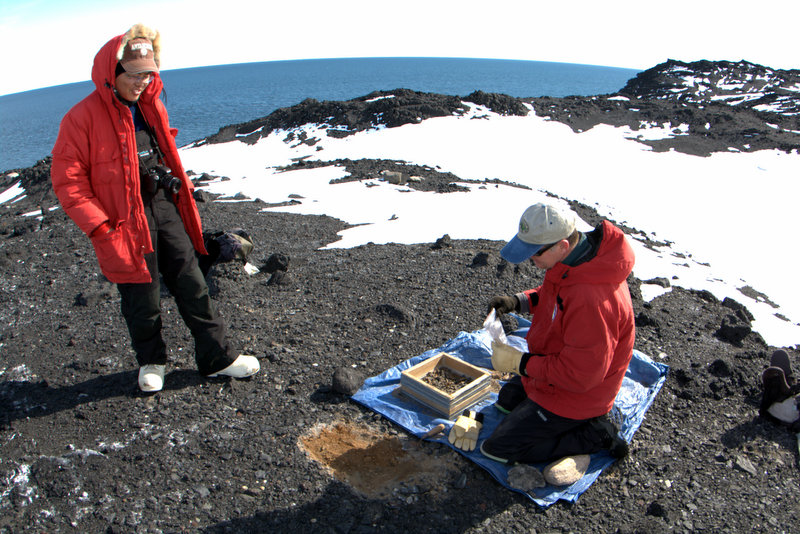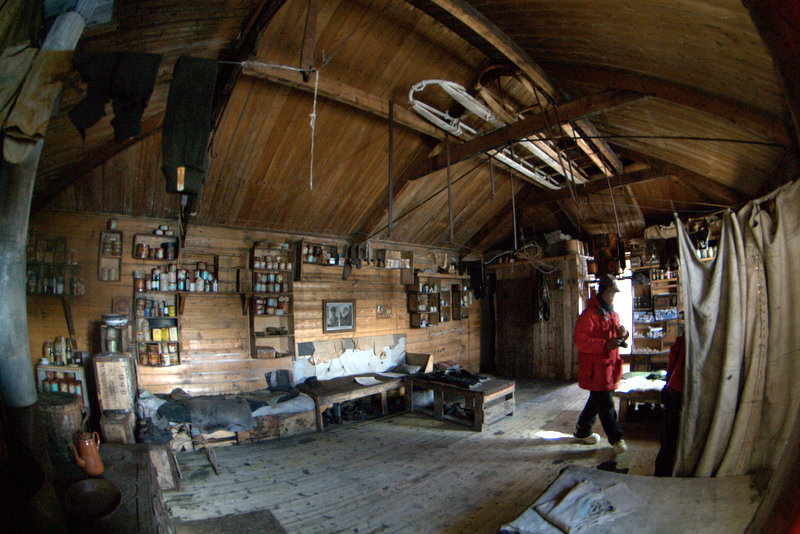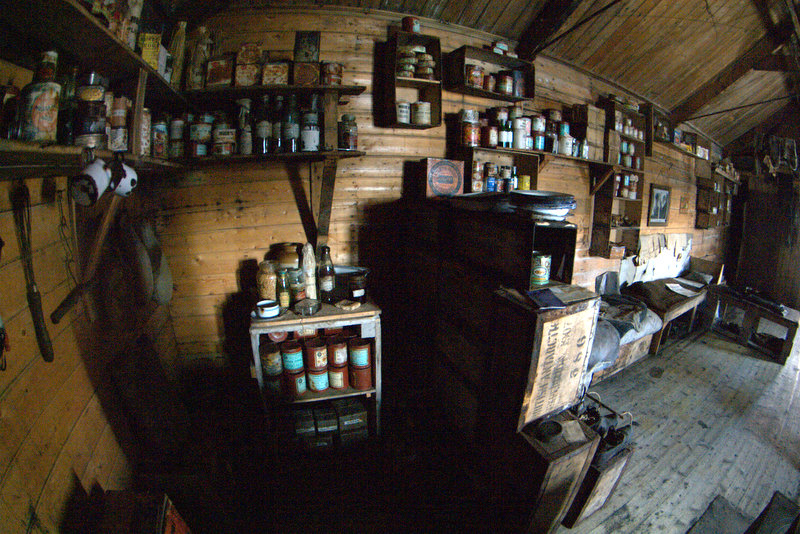McMurdo Miscellanea and Cape Royds
This update covers a bit of the McMurdo experience and our first field outing to Cape Royds. Monday morning began with a series of briefings/slideshows/films about Crary Lab safety, waste disposal, and behavior within ASPAs (Antarctic Specially Protected Areas). In the afternoon Jurek, Steve, and I attended our Field Safety Training refresher course, a requirement every year for anyone headed into the field for any reason. Since it is Tao’s first time down to McMurdo he was required to attend Happy Camper School- a two-day course on the Ross Ice Shelf that involves a variety of instruction and a night out in your shelter-of-choice (he chose a tent). Our refresher was unremarkable except for a couple of interesting statistics. Our instructor Brian revealed that there had been 38 fatalities in the Ross Sea Sector over the last fiscal year (all maritime, but none-the-less impressive), and secondly that our refresher group had a total of 210 seasons of experience in the Antarctic! One scientist alone had been coming down here to work in the Dry Valleys since the late 1970s, so there was a wealth of experience and “uh-oh” moments recounted during introductions. A few hours of reviewing the contents of survival bags, setting up tents, lighting stoves, and discussing radio protocols and we checked off one more item on our “to do” list.
After more chores around town and computer work in the lab we decided to stretch our legs with a stroll down to the end of Hut Point and a visit to Scott’s original hut. Along the way we saw work in progress on the new pier- the former ice pier was carried away last season when the sea ice in the Sound had blown out- an occurrence remarkable in more than a decade. It had caused quite a bit of hub-bub around here since it took a truck, a Jamesway hut and quite a bit of other stuff with it when it went. To read more about how the equipment was rescued check out this article in the Antarctic Sun. We were joined on our visit to the hut by a couple of wide-eyed undergraduate students Brenda Hall brought down for her glacial field studies this season. The hut interior was as dark and cramped as I remembered, and it is clear why the Scott party only used it for storage and occasional overnighting while in transit between depots and Cape Evans. I shot a short video walking through the entire hut to convey a sense of how marginal it was in comparison to the other huts of Ross Island. After a half hour of surveying the artifacts arrayed about the hut we locked it back up, visited Vince’s Cross in a light but chilly wind, and headed back to town for the evening.
Video: Walkthrough of Scott's original Hut Point Hut
It seems that every field season down here has some sort of glitch in the works that has profound impact on the work, for instance the 10-day blizzard in 2005, and this year it is the availability of helicopters for transportation. Normally there are three large ships available for camp movements (two Bells in the US program, and one Kiwi ship), and two smaller aircraft available for day trips (A-Stars). But this year there is a major project underway on Pine Island Glacier (PIG) in Ellsworth Land, far to the east of here close to the Antarctic Peninsula. The glacial ice at PIG is moving faster than on any other ice streams in Antarctica, and a ton of research is being focused on why and how, in order to understand the implications for the future of glaciers and ice shelves in Antarctica in a warmer world. So a lot of resources have been dedicated to establishing and servicing field camps on the glacier and its environs, including packing up the A-Stars for transport by Hercs (the LC-130 ski planes) to PIG- we saw them dismantled on the runway at Pegasus when we arrived. But the weather window that allows flights between McMurdo and PIG has been elusive, since it involves a refueling stop along the way three disparate sectors of Antarctica have to share good weather at the same time, an unlikely prospect at best. The PIG effort has stalled, and is likely to be cancelled for this year, but meanwhile McMurdo is down to three ships, and Helo Ops is overbooked for the time being unless the A-Stars are put back into local service. This means that we will not get helo time as needed, and may crimp our (and many others) activities for now. But we did manage to get on the schedule for a day trip to Cape Royds (a short flight of only 15 minutes or so) for Thursday.
The helo schedule showed that we would be riding to Cape Royds on the Kiwi ship with Rob McPhail- old-hand pilot that we first flew with during our 2000-2001 field season. The new Kiwi ship is a Eurocopter EC-130, a fancy ride with a roomy interior and the ability to carry passengers up front (the Bell 212s have controls in both front positions, so only Helo Techs get to ride upfront). Tao and I got the prized seats, and I shot a video of the take-off from McMurdo and our flight over the Scott Hut and across the Sound below Mt. Erebus. We scored a perfect, sunny day with unrestricted visibility, so the ride was typically scenic. On landing we were greeted by a slew of folks camping at Royds- of course penguin-researcher David Ainley and his assistant, schoolteacher Jean Pennycook (see David's Penguin Science website for more details of their work at Royds, Crozier, etc.). But also at the helipad was Italian geomorphologist Carlo Baroni and two colleagues: Yvette Wharton from University of Auckland and Sandra Lorenzini from the University of Pisa. They are also working on paleo penguin sites, collecting samples for DNA analysis by one of their genetic collaborators. We exchanged greetings, gathered our gear, and headed for the colony.
Video: Helicopter takeoff from McMurdo
While Steve and Tao prospected for ornithogenic sediments I wandered down to the beach to see if I could get some good video footage of the birds in the water. The difference between their terrestrial locomotion and their mastery of the water has always amazed me, and the new camera allowed me to capture a bit of that transition as I filmed. Walking back to the colony I witnessed some penguin/skua interaction- a pair of Adelies had gotten a little too close to a skua chick, making the parent unhappy, but the penguins repeatedly repelled the similar-sized skua with a team effort. And I finally was able to capture a group of non-breeders tobogganing around on the fresh snow- Steve is sure that not only is it an efficient way to travel, they have fun doing it.
Video: Adelies enter (and exit) the water at Cape Royds
Video: Adelie/skua interaction at Cape Royds
Video: Adelies travel by toboggan around Cape Royds
We hiked north on the rugged volcanic terrain to relocate and map some old sites that we had found on previous years- radiocarbon dates from the 2010 season confirmed that these were the oldest occupations on Ross Island at 3915±20 radiocarbon yr BP (calibrated to 2969 yr BP). As we hiked we found Baroni et al. excavating a fossil mound nearby. I was a bit surprised by their field methods, scraping the surface with a full-sized shovel then picking through the sediments for eggshell fragments. Steve assessed a few other mounds in the area, and excavated a couple of shallow deposits where he recovered some more, likely old samples of bone, feathers, and eggshell. After relocating and confirming locations of all our sites from previous years, we hiked back to the colony to retrieve our gear and revisit Shackleton's Nimrod Hut.
As we walked to the hut we passed the latest flags sent from elementary school students to Jean at Cape Royds. She has started an educational program about her work with Adelie penguins all over the US, and she encourages students to create flags about the birds and send them to her to photograph in front of the colony for the schools. She told us that the response has been overwhelming, with batches of flags arriving with every helo flight, so that now a good part of her day involves hoisting the flags and photographing them. The hut has just been restored by the New Zealand-based Antarctic Heritage Trust, and I was interested in seeing how it may have changed since our last visit. It is now supposedly in the state closest to how it was when it was abandoned over 100 years ago, including having the whiskey found under the hut two years ago replaced. Jean saw them put the crate with bottles back, but she questioned whether they were full of scotch or iced tea! Yvette mentioned that she had brought down some of the liquor that was produced following the analysis of the century-old recipe, but David said that it tasted like Old Bushmills to him. The hut did look great inside, with the artifacts tidily arranged around the room, and canvas dividers back in place to form rooms. It is a far more pleasant structure than the Hut Point Hut, and I can imagine it served well as a refuge for the attempt on the pole, and the first ascent of Mt. Erebus. Soon we locked the hut back up and trudged back to the heli pad to don ECW and wait for Rob to pick us up. Right on schedule he arrived, we loaded up and headed back for McMurdo in time for dinner. On the flight I happened to notice that our airspeed was 120 knots (~140 mph)- a respectable speed for this sleek ship.
Back in McMurdo we finished out the week planning for trips ahead- it now is looking promising for us to go both to Cape Bird and Mario Zucchelli station, two of my favorite places down here by far. And we had a batch of DV’s (Distiguished Visitors) drop by, a Staff Delegation from U.S. House of Representatives, including the Minority Clerk on the House Appropriations Subcommittee on Homeland Security,the Communications Director for the House Appropriations Committee,and the House Appropriations Subcommittee on Commerce, Justice & Science, the Coalition Director of the House Appropriations Committee, and a member of the Professional Staff, House Appropriations Subcommittee on Commerce, Justice & Science. They seemed quite busy but interested on this end of their trip- they had been to the South Pole the day before.
Video: Rob brings the EC-130 in for a smooth landing at Cape Royds
Click on the images below for a larger version.
 |
 |
 |
 |
 |
 |
 |